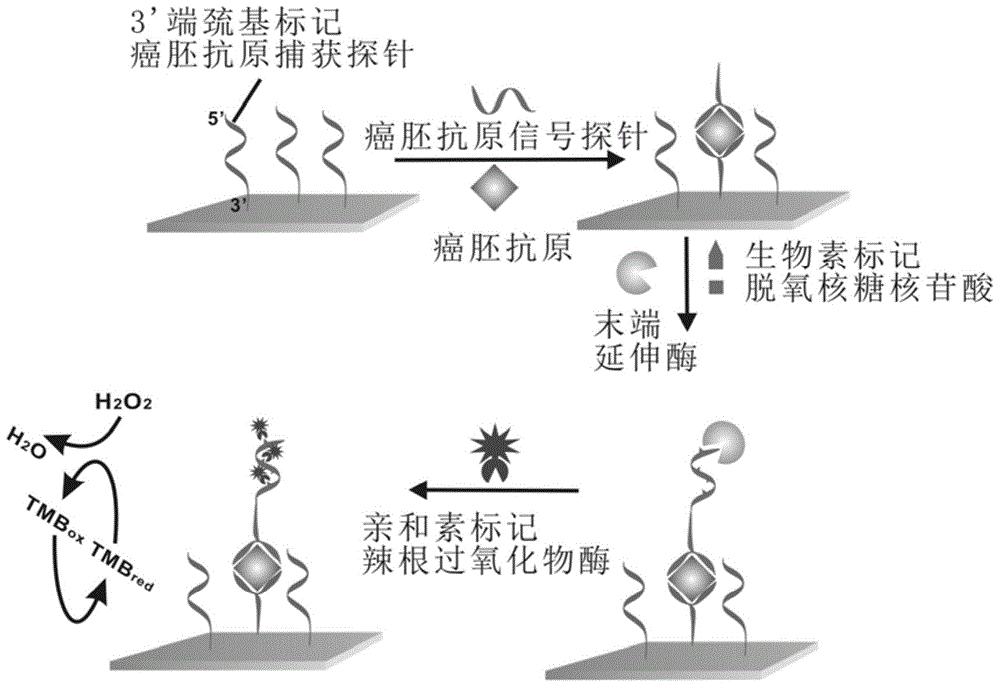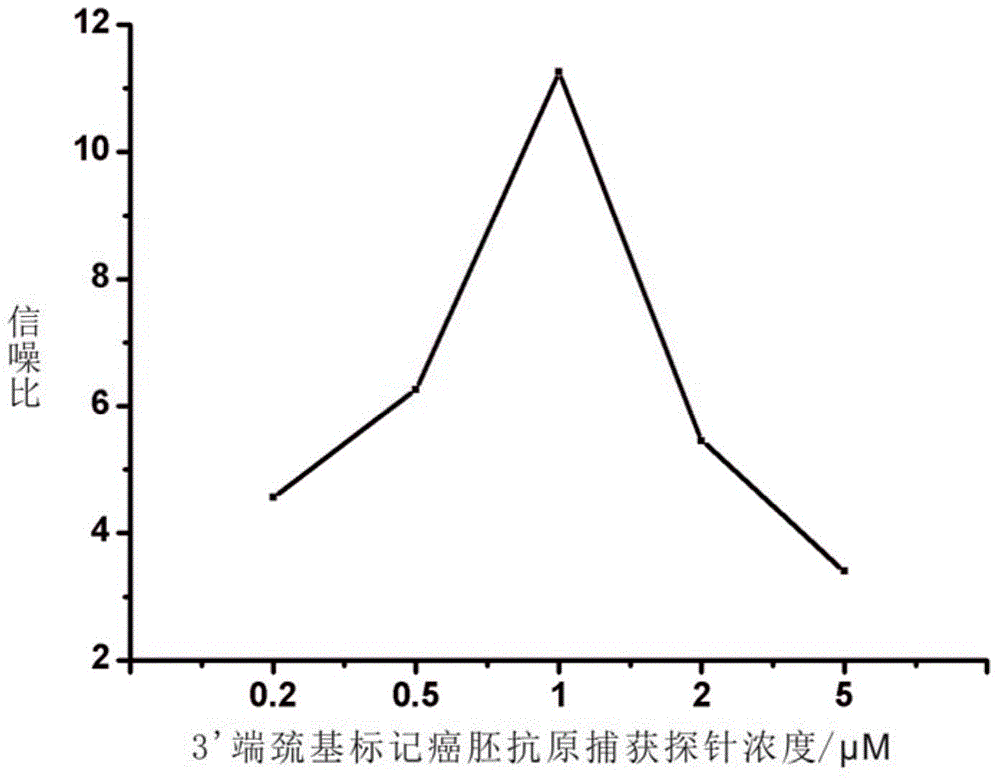Method for detecting carcino-embryonic antigens by using electrochemical nucleic acid aptamer sensor on basis of terminal elongases
A carcinoembryonic antigen and nucleic acid aptamer technology, applied in the field of electrochemical biosensor research, can solve the problems of increasing cost, high cost, increasing the complexity of the reaction system, etc., achieving strong applicability, high sensitivity, easy simplification and miniaturization. the effect of
- Summary
- Abstract
- Description
- Claims
- Application Information
AI Technical Summary
Problems solved by technology
Method used
Image
Examples
Embodiment 1
[0036] Example 1: The influence of the assembly density of the 3'-end sulfhydryl-labeled carcinoembryonic antigen nucleic acid aptamer capture probe on the detection results of electrochemical signals.
[0037] The method for detecting carcinoembryonic antigen by using the electrochemical nucleic acid aptamer sensor based on terminal elongase according to the present invention, taking the carcinoembryonic antigen solution as the target object, and the establishment steps of the carcinoembryonic antigen detection system based on the terminal elongase electrochemical sensor As mentioned above, the concentration of blocking solution OEG is 1 mmol / L, the concentration of carcinoembryonic antigen is 1 μg / mL, the concentration of carcinoembryonic antigen nucleic acid aptamer signal probe is 1 μmol / L, and the assembled 3' terminal thiol-labeled carcinoembryonic The concentration of the antigen nucleic acid aptamer capture probe was 0.2, 0.5, 1, 2 and 5 μmol / L, and the influence of dif...
Embodiment 2
[0038] Example 2: Effect of OEG blocking concentration on electrochemical detection results.
[0039] The method for detecting carcinoembryonic antigen using the terminal elongase-based electrochemical nucleic acid aptamer sensor of the present invention takes the carcinoembryonic antigen solution as the target object, and all the operating steps are as described in Example 1, wherein the assembled 3' terminal thiol The concentration of labeled carcinoembryonic antigen nucleic acid aptamer capture probe is 1 μmol / L, the concentration of carcinoembryonic antigen is 1 μg / mL, the concentration of carcinoembryonic antigen nucleic acid aptamer signal probe is 1 μmol / L, and the concentration of blocking solution OEG is 0.5, 1, 1.5 and 2mmol / L, analyze the impact of different blocking concentrations on the detection of electrochemical signals, the analysis results are as attached image 3 As shown, the OEG concentration is lower than 1mmol / L, and the signal-to-noise ratio is enhanced...
Embodiment 3
[0040] Example 3: Effect of concentration of carcinoembryonic antigen nucleic acid aptamer signal probe on electrochemical signal detection results.
[0041] The method for detecting carcinoembryonic antigen using the terminal elongase-based electrochemical nucleic acid aptamer sensor of the present invention takes the carcinoembryonic antigen solution as the target object, and all the operating steps are as described in Example 1, wherein the assembled 3' terminal thiol The concentration of labeled carcinoembryonic antigen aptamer capture probe was 1 μmol / L, the concentration of blocking solution OEG was 1 mmol / L, the concentration of carcinoembryonic antigen was 1 μg / mL, and the concentration of carcinoembryonic antigen aptamer signal probe was 0.2 , 0.5, 1, 2, and 5 μmol / L to analyze the influence of different carcinoembryonic antigen nucleic acid aptamer signal probe concentrations on the detection of electrochemical signals, and the analysis results are shown in the attach...
PUM
 Login to View More
Login to View More Abstract
Description
Claims
Application Information
 Login to View More
Login to View More - R&D
- Intellectual Property
- Life Sciences
- Materials
- Tech Scout
- Unparalleled Data Quality
- Higher Quality Content
- 60% Fewer Hallucinations
Browse by: Latest US Patents, China's latest patents, Technical Efficacy Thesaurus, Application Domain, Technology Topic, Popular Technical Reports.
© 2025 PatSnap. All rights reserved.Legal|Privacy policy|Modern Slavery Act Transparency Statement|Sitemap|About US| Contact US: help@patsnap.com



